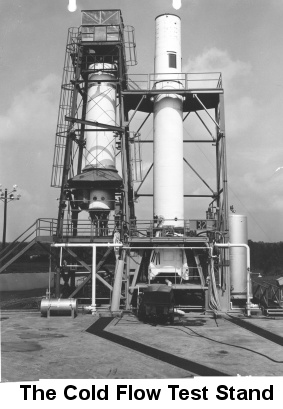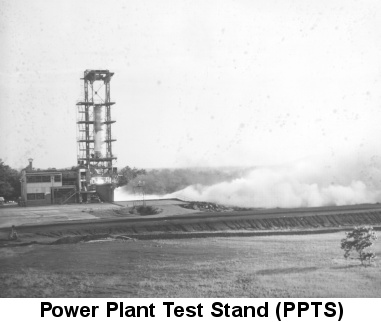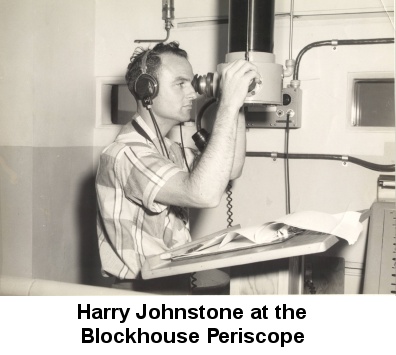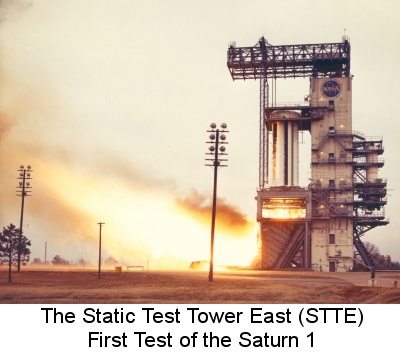
The Life and Times of Harry M. Johnstone
| Johnstone was, until his retirement in 1979 an engineer with the NASA Marshall Space Flight Center, whose career spanned the development of launch vehicles from the Redstone to the Space Shuttle. These articles also appear in a book called 50 Years of Rockets & Spacecraft. |
Part 1 -- Early 1950s. The Test Laboratory of the U.S. Army Ordnance Missile Laboratory
 |
In the early 1950s, Wernher Von Braun and approximately 130 German scientists and engineers left El Paso, Texas and moved to Redstone Arsenal near Huntsville Alabama. Here, they were to design missiles for the U.S. Army. Von Braun planned to locate the Design, Manufacturing, Quality Engineering and Test Laboratories all within a three-mile radius. All other missile contractors with similar operations had these essential functions many miles apart. Design engineers could be on the test stand within a couple of hours to start redesign of problems that had surfaced during static firings. This concept made Redstone Arsenal unique and resulted in rapid and cost effective development of missile propulsion elements. A German engineer directed each laboratory.
Martin Schilling was director of Test Laboratory and Herman Weidner, Rudi Beichel and Bernard Tessmann were responsible for the design and construction of the Guided Missile Test Facility (1951-1955) now known as the East Test Area. This facility consisted of the Static Test Tower East (STTE), Static Test Tower West (STTW), Power Plant Test Stand (PPTS), Cold Calibration Test Stand (CCTS) and the Components Test Facility (CTF). These facilities would later test the Redstone engine (75,000 lb. thrust), Jupiter engine and flight stages (135,000 lbs. thrust), H-1 Engine (150,000-208,000 lbs. thrust), Saturn I H-1 engines (eight of which produced 1.2 million lbs. thrust), and the F-1 engine (1.5 million lbs. thrust).
From the mid 1950s to early 1970s, Karl Heimburg was the Test Laboratory director. Heimburg was very unique in that he told his engineers that they not only were responsible and accountable for test operations, but also for the safety, quality and reliability of the test stand, test vehicle and test operations. If you could not handle the whole job, he would get someone to replace you. And we all understood what that responsibility was. That meant, the "Buck Stops Here" (with the test engineer or test director in charge). No one ever said, "Quality, why didn’t you catch that problem." Therefore, we did not initially require many outside safety and quality people. Dodge Olds was our safety man, mostly for burning permits. Heimburg knew what he wanted and expected his people to accomplish the job. He was a tough taskmaster. Most of the engineers afraid of him and his wrath. However, Karl Heimburg was only interested in an efficient and safe operation. In later years, I came to respect him more and more. I have many Heimburg stories, but a couple stand out in my memory.
I was assigned as section chief of the PPTS. Gordon Artley and I went to Auburn University on a recruiting trip and I left Jim Williams and Elmer Ward in charge of firing the Jupiter engine for the first time with me absent. Upon arrival back at Test Laboratory, Mr. Heimburg called me into his office and started yelling at me. He told me, "if you ever leave your job again you are out of here", pointing to the door. He continued, "I want you present at every static firing on this test stand." I should have been honored that he respected me and had that much confidence in me.
On another occasion, Elmer Ward and I had been to Manufacturing Laboratory to verify that we had the correct bolts to install the nose cone on the Jupiter vehicle. When the nose cone arrived at the test area, Elmer Ward and I were on the upper level of the test stand at the nose cone interface when Heimburg showed up. The nose cone was lifted up by a crane and placed at the vehicle interface. An attempt was made to install the bolts, but they were the wrong size. Heimburg had heated words with me because he thought we had not verified these bolts. Before I knew it, I blurted out in anger, "I will throw you off the test stand." He was speechless. No one had stood up to him before and he just walked off. Elmer and I had already checked these bolts out with Manufacturing Laboratory and were told that they were the right size. We knew we were not guilty!
My dream as a boy was to be an airline pilot. However, upon graduation from High School in 1942, Uncle Sam had other plans and I joined the Army Air Corps. I became an Advanced Trainer (AT-6) flight instructor (1943) and later I flew RP-63s (with armor underneath wing and fuselage) making 90 degree pursuit curves for camera gunnery passes on B-29s while they shot plastic bullets at me from their waist guns. One of my buddies was shot down doing this and landed in the Texas desert at Laredo. At the end of WW2, I entered Auburn University to get a degree in Aeronautical Engineering. Upon completion of college, I had changed my mind. The Space Program was just getting off the ground. I then went to work for the National Advisory Committee for Aeronautics (NACA) at Langley Field, Virginia, in 1949 as an Aeronautical Research Scientist. From there, I went to Huntsville, Alabama in May, 1951to work for the Army at the Redstone Arsenal. Ernst Seiler was my supervisor.
I was assigned to operate a blow down tunnel, which tested two dimensional shark mouth ramjet test articles. I performed tests for Kraft Ericke and Harvey Connell. Dr Von Braun was planning to attach wings to the flight vehicles with shark mouth ramjets built into the wings. This design would have given these vehicles a range of over 1,500 miles and put the Army in competition with the Air Force; therefore, Congress canceled the program. Dr. Von Braun gave the Test Laboratory personnel a choice of staying with Test Laboratory or transferring to Aeroballistics Laboratory with the wind tunnel. I choose Test Laboratory and was transferred to the Interim Test Stand.
In May of 1953, I was assigned to construct, activate and operate a Cold Flow Test Stand, which was built next to the now famous historical Redstone Interim Test Stand. We utilized a Redstone Missile "bob-tail" engine (thrust chamber removed) and ran water/water in place of liquid oxygen/alcohol test to verify design of tank pressurization, anti-vortex drain hardware, hydrogen peroxide catalyst beds, turbopumps and turbines. We learned that the fuel tanks must be pressurized while draining. Otherwise, as the air rushed into the tank around the open fuel vent valve, the air velocity pulled the vent closed, resulting in a vacuum in the tank. The tank pressurization served to pop the tank skin back to original configuration. I operated the firing panel for Bill Grafton on Redstone Flight Missile #3 during static firing.
Part 2 -- Mid 1950s. The Test Laboratory of the U.S. Army Ordnance Missile Laboratory
 |
In mid-1955, I was assigned Section Chief of the Power Plant Test Stand (PPTS), and was given the privilege and responsibility to modify and activate the first static firing test facility of the newly constructed Guided Missile Test Facilities. Jim Williams was my lead engineer withToddy McClendon, Fred Baxter Paul Guyse, Charles Perry and Bill Stinnett serving as his technicians. PFC Karl Kastner, of the U.S. Army, was my electronic and control engineer, with Norman Tidwell, Lavernne Kliner and Jim Copeland serving as his technicians. Joe Janaski was the instrumentation engineer. Bill McMahan, Ron Harris and Leroy Reynolds were his technicians.
Rocketdyne personnel operated this facility and performed acceptance firings of flight Redstone engines. Working with Rocketdyne’s design and operations personnel Chuck Anselmo, Wayne Boruff and lead foreman McHenry, I gained invaluable experience of the test stand and rocket engine operations. The engineers had little test experience and technicians were fresh out of the cotton mills. There were extreme problems of short time schedule, lack of facility hardware, and insufficiently trained personnel. Still, against tremendous odds, we were able to complete the preparations of the test stand and initiate firings on schedule by August 13, 1956.
Our test team was given a letter of commendation. Many times, we put in 12 to 14 hour days. Some engineers and technicians had a 1.5-hour drive to their homes in nearby towns. These guys were going to sleep at midnight and getting up again at 4:00 AM to head back to work. I’m reminded of some of my good lawyer and doctor friends in Huntsville who poked fun at us as the typical "Government Worker" that did nothing at work. None of us ever backed up to the "payroll window."
In those days, things were moving along rapidly. I was assigned test director for the First Flight Jupiter Missile. Elmer Ward was my lead engineer and we moved to the Static Test Tower West (STTW) to modify and activate the facility. Toddy McClendon, Fred Baxter, Paul Guyse and J. M. Stapler were the technicians. Paul Cates was the electrical and control engineer, Gardiner Maples, Kliner and Copeland were the technicians. Tom Micalek was the instrumentation engineer McMahan, Harris and Honeycutt were the technicians. Within 6 months, we performed the first static firing on February 12, 1957 with support from Erich Kaschig, Karl Reilmann, Jim Williams, Robert Saidla, Axel Roth, Ken Riggs, Pfc. Paul Charbin, and Pfc. Don Sommers. Because of this rapid facility modification activation and static firing of the first flight Jupiter, our test team received another letter of commendation from Gordon Artley.
The vehicle was placed in the test stand and all mechanical and electrical interface connections were installed. Within 2 hours, an "overall" or automatic sequence test was run successfully, indicating that all planning was perfect. The "overall test" was started with a firing command. Once we pushed the vehicle firing command switch, the automated sequence would take the engine to main stage (100 per cent thrust). The first firing took place about 10:00 PM. An explosion occurred in the LOX start tank discharge valve and we lost all control pressure. We could not open the tank vent valves and the critical delta pressure redline across the LOX and tuel tank bulkhead was 11 psi. The LOX was boiling and the tank pressure was building, approaching the redline value. Karl Heimburg said "Harry what are you going to do?" Dr. Von Braun, Hermann Weidner and Heimburg were all standing behind me as I looked at the recorders that said we were in trouble.
 |
Paul Kennedy, the general foreman, called from the pill box, a rear vantage point of observation, and said "I will connect another high pressure trailer to the high pressure gas system". This was a dangerous mission with the LOX and fuel tanks near rupture. He continued, "Harry, we will go to the seventh level. You open the LOX tank vent valve and we will block it open." This we did and Paul Kennedy was a hero. We secured the missile and all went home relieved that we did not loose the First Flight Jupiter. From this failure, we designed a fail-safe system that would open the flight vents in case of control pressure or power failure. This design was incorporated in all test facilities from that day forward including the Main Propulsion Test Article (MPTA)) at Stennis Space Center (SSC), Mississippi.
After the test, we found that the Rocketdyne LOX lubricant (QC20026) in the LOX start tank discharge valve was not compatible with LOX, producing an explosive mixture. Dr. William Lucas of the Materials Test Branch developed a LOX lubricant which was LOX-compatible. It was used in all systems manufactured in Huntsville thereafter. Karl Heimburg called it "Lucas lube."
Later, we static fired the Flight Jupiter successfully and sent it on to be launched at Cape Canaveral, Florida. There, after a flight of 110 seconds, it exploded. Investigation linked the failure to a lack of gear box lubrication. We put a check valve in the gear box lube oil drain line to keep a 3-4 psi positive pressure in the gear box. We found out that the lube oil in the gear box broke down (foamed) and could not be used as a lubricant at altitude in the vacuum of space.
We used micro switches to indicate valve open or closed positions and on the first Jupiters These micro switches were not very reliable. When all valves on the vehicle and engine were in the correct configuration, we received a preparation complete green light. Preparation complete was the signal to the test conductor that the vehicle was in readiness to give firing command. Occasionally, we did not get the preparation complete light, even when we knew that a particular valve was in the correct state. I had Paul Cates and Bill Lindsey design a preparation complete bypass switch. This switch was named "Damn the Torpedoes" and allowed us to press firing command for a successful test. I took full responsibility if it did not perform correctly.
Gordon Artley was then chief of the System Test Branch and assigned me chief of the PPTS. I returned to modify and activate the test stand for Jupiter research and development testing. Elmer Ward and Jim Wllliams were my support engineers, and Toddy McClendon, the lead foreman. Jessie Bradley was my electronic and control engineer and Norman Tidwell, Lavernne Kleiner, Paul Strange and Jim Copeland were the technicians. Marty Ferrieo was the instrumentation engineer, McMahan, Harris and A.B. Hall were the technicians. On September 20, 1958, a rainy Saturday at 11:30 AM, while static firing the Jupiter engine, an explosion occurred at the gas generator valve inlet. I was looking through my periscope and observed through an opening in the vehicle tail structure an explosion at the gas generator and I cut the firing off in less than a second. However, I lost control of the facility power, the boat tail (vehicle’s enclosed aft compartment) gaseous nitrogen purge and Firex (engine water sprinkler system). Shrapnel from the explosion punctured both the LOX and fuel lines above the pre-valves, causing a leak that got bigger and bigger.
These leaks developed into a huge cutting torch that destroyed a 30-inch "I" beam. The engine fell out of the test stand into the deflector pit. The tank, which normally is held in place by three bolts, only had one bolt that had not been cut by the fire. We rebuilt the facility and static fired an engine in 21 days another indication that our Test Laboratory personnel were among the top three per cent of all test personnel nationwide.
Because of this experience, we learned several important lessons, including:
1) Firex water and gaseous nitrogen emergency purges in the engine area should have normally open valves, that fail open, in case of control pressure and power failure
2) All electrical cables that cross the facility interface from inside the building to the outside must be fused.
This failure, along with the first Flight Jupiter failure, gave us the experience to build all future test facilities fail-safe for electrical and control pressure failures. An investigating committee chaired by Dr. William Lucas concluded that the explosion was caused by LOX contamination from an unknown source. The most probable source was the LOX start tank quick disconnect coupling.
After these Jupiter engine tests, we modified the PPTS to static fire the H-1 engine in preparation for testing the 8-engine cluster on the Saturn 1.
Part 3 -- 1960 - 1963. Test Laboratory - NASA
President John F. Kennedy, on national television, confidently told the American people that we would put man on the moon by the end of the decade. For those ten years, we performed like the World War II generation, of which I was also a part. At that time, I was Chief of Facilities and Operations for all vehicle and engine test facilities in Test Laboratory. In 1960, Karl Heimburg assigned me as Test Director with responsibility for the static firing operations of the Saturn 1 cluster test vehicle and subsequently the flight vehicle at the Static Test Tower East. This vehicle was over 20 feet in diameter and was quite an increase over the 70-inch diameter Redstone and the 105-inch diameter Jupiter. It also had a cluster of eight H-1 engines, which was a big increase in complexity.
Jim Williams and Elmer Ward were the engineers in charge of the H-1 engine readiness and operations. Lemuel McClendon was lead foremen. Guyse, Stinnett Baxter, Ball, Perry, Conley, Stapler, Brannun were technicians. Karl Reilmann and Orville Driver were responsible for the tankage and associated equipment and suction ducts. Powers, Terry, Burrough, Yeager, Chandler and Turner supported Karl and Orville. Erich Kachig, Bob Saidla, Ken Riggs, and Don Bowdon were responsible for the activation and modification of the facility. Jack Waite was responsible for the structural testing of the thrust structure and the thrust measuring system. Jack coordinated with Jim Sawyer and John Flora of the Structural Laboratory for the structural test. Henry Auter, John Shirey, Paul Cates, and Bill Lindsey were the electrical/electronic engineers. Maples and Kliner served as their technicians. Marty Ferrieo, Bob Henry and J Derbonne were the instrumentation engineers, with Merrill, McClugage, Morring, and J.W. Smith serving as technicians.
The vehicle, less the engines, suction ducts, and the LOX vent valve, was received at the test stand on February 28, 1960. A 2.25 million-pound test load using eight 500,000-pound hydraulic jacks was used to proof test the thrust structure. This proof load structure was removed and the suction ducts and engines for engine positions 6 and 8 were installed.
No flight LOX vent valve was available, so a LOX prevalve was installed in place of the vent valve. This was another innovation of Test Laboratory that allowed us to rapidly move toward the static firing date. We installed flak curtains between engines to prevent shrapnel damage if adjacent engines exploded.
On our propellant load test, Tom Winstead of Structures and Mechanics Laboratory monitored the LOX pump inlet temperature during propellant transfer to prevent a LOX geyser. Jerry Vanniman supported Tom. A geyser was caused when LOX boiled at the pump inlet, causing a gas bubble that would push the liquid out of the pump inlet ducts and back into the tank. The LOX would then rush back into the vacated inlet duct and stop at the pump inlet. This instantaneous stop caused pressure transients beyond the rupture pressure of the line, possibly destroying the propellant line and dumping hazardous propellants in the test area.
On the first propellant load test, the LOX pump inlet reached the critical temperature for geyser formation. We had to de-tank and install a helium bubbling system in the LOX pump inlet to maintain a cold temperature. On the next propellant loading, the helium bubbling design performed perfectly, meeting the required critical LOX pump inlet temperature for engine start. Again, we proved that Test Laboratory is a critical link to space flight.
After all electrical and instrumentation systems were installed and checked out, a static firing of two engines took place on March 28, 1960, just 30 days after the vehicle arrived. Bob Saidla was the test conductor. This short schedule was due to the organization and discipline of government employees working under Karl Heimburg, who held them responsible and accountable for their actions. By contrast, contractors operating under government oversight would have required numerous intermediate quality checks that would have extended the static firing date by many months.
Next we installed two more engines and fired all four. By April 29, 1960 all eight engines had been installed and were fired for a total of 110 seconds. Looking through my periscope, I saw two engines start. Then, at 300 millisecond intervals, additional groups of two engines started until all eight were roaring. One of the most exciting days of my life was to see the first eight-engine cluster in the world rumble into main stage.
No heat shield around the engines was initially installed. On test SAT-9, we installed heat shields, bringing the test article into flight configuration. It was so cold in the enclosed boat tail (the enclosed aft compartment of the vehicle) that I asked blockhouse instrumentation specialist John Kastanakis to place several thermocouples to measure the temperature. We noted boat tail temperatures of zero degrees F. We stopped and asked Rocketdyne if they had ever fired at this temperature. They said yes and gave us the OK to proceed. BIG MISTAKE! We destroyed eight turbines by exceeding the turbine inlet temperature red line and got automatic cutoff at 1.7 seconds. All eight sets of turbine blades were eroded because the cold temperature in the boat tail area caused the fuel cracking check valve of the gas generator to be slow opening. The LOX-rich mixture in the gas generator caused such high temperatures that the turbine blades were melted. We determined that a boat tail heating system must be installed, proving again that without static testing before launch, major delays and failures are inevitable.
Later, we had a command performance to test the Saturn 1 vehicle for President John F. Kennedy and Vice President Lyndon Johnson. After a successful firing, I went to the base of the test stand to mingle with the dignitaries. I had my hard hat on with "Johnstone" printed on it. Vice President Johnson came up to me, shook my hand, looked at my hard hat, and said, "We must be cousins."
 |